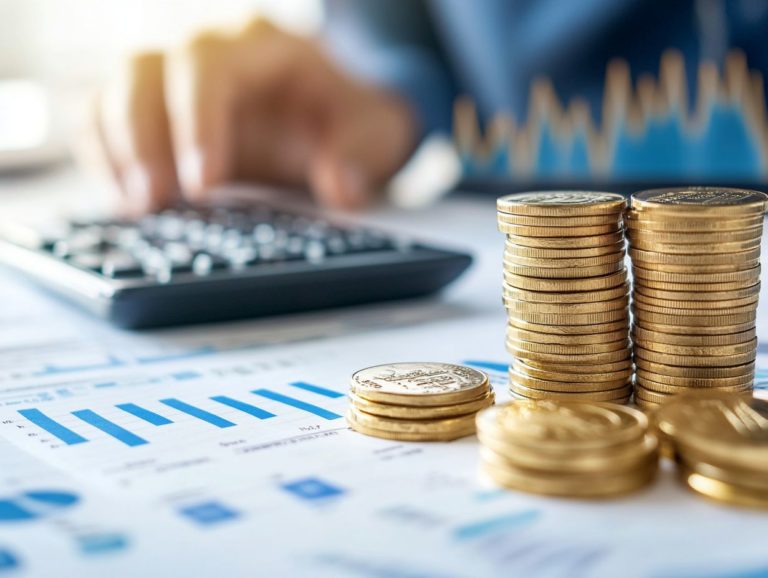Tax Regulations Around Precious Metals in 2024
Investing in precious metals like gold, silver, and platinum presents a distinctive opportunity for you to preserve wealth and diversify your portfolio.
Navigating the complexities of the tax rules related to these investments can be quite challenging. Get ready to dive into the exciting world of precious metals and taxes! This overview will guide you through precious metals, current tax regulations, and essential elements such as capital gains tax and reporting requirements.
You will discover strategies designed to minimize your tax burden while maximizing your investment returns, especially as potential updates in 2024 are on the horizon.
Deepen your understanding and empower yourself to make informed and bold choices today in the precious metals market.
Contents
- Key Takeaways:
- Current Tax Regulations for Precious Metals
- Changes to Tax Regulations in 2024
- Strategies for Minimizing Taxes on Precious Metals
- Frequently Asked Questions
- What are the current tax regulations around precious metals in 2024?
- Why is it important to stay updated on tax regulations?
- Are there any proposed changes to the tax regulations around precious metals in 2024?
- What is the capital gains tax rate for precious metals in 2024?
- Do I have to pay taxes on precious metals that I inherited in 2024?
- Is there a certain value threshold for paying taxes on precious metals in 2024?
- Are there any tax benefits for investing in precious metals in 2024?
Key Takeaways:
- Precious metals, such as gold and silver, are subject to taxation, and it is important for investors to understand the current tax regulations.
- In 2024, there may be changes to tax regulations for precious metals that could impact investors. It is important to stay informed and plan accordingly.
- Investors can minimize taxes on precious metals through strategic investment and holding strategies, as well as utilizing tax planning techniques.
Overview of Precious Metals and Taxes
The intersection of precious metals and tax regulations is a complex yet vital topic for you as an investor seeking to safeguard your wealth. Precious metals like physical gold, silver, platinum, and palladium have long been recognized as reliable stores of value, especially during periods of economic uncertainty and currency fluctuation.
These metals not only act as a hedge against inflation but also carry specific tax implications that can influence your investment choices significantly. Understanding the details of taxation on these assets, including capital gains tax—which is the tax on profit made from selling an asset—and the reporting requirements established by the Internal Revenue Service (IRS) is essential as you navigate this intricate financial landscape.
What are Precious Metals?
Precious metals are rare, naturally occurring elements that hold considerable value due to their economic properties. Think of gold, silver, platinum, and palladium—these metals are not just shiny collectibles; they are tangible stores of wealth, sought after for their intrinsic value and demand across various industries.
You might find yourself particularly drawn to gold, celebrated for its historical stability and allure as a safe haven investment. Silver shines brightly not only in industrial applications but also as a hedge against inflation, making it a versatile choice.
Then there’s platinum, which boasts rarity and plays a crucial role in both the automotive and jewelry markets. This positions it uniquely, often commanding higher prices than its counterparts.
Meanwhile, palladium is making waves, especially in the realm of catalytic converters, driving demand and pushing prices upward. By understanding the nuances in market demand and investment potential among these metals, you can make informed and bold choices today for a diversified investment portfolio that capitalizes on the allure of precious metals.
Taxation of Precious Metals
The taxation of precious metals requires understanding how the IRS classifies these assets and the accompanying tax implications that emerge when you decide to sell. When you sell physical gold, silver, or other precious metals, you may realize a taxable gain, subject to capital gains tax. This tax can fluctuate based on how long you’ve held the asset and the profit you’ve made.
If you hold an asset for one year or less, you’re looking at short-term capital gains, which are taxed at ordinary income tax rates—often much higher than those for long-term capital gains. However, if you’ve held the asset for more than a year, you can take advantage of reduced rates, typically ranging from 0% to 20%, contingent on your overall income level.
To accurately report these transactions, you’ll need to complete specific IRS forms. Schedule D will detail your capital gains and losses, while Form 1040 is required for your annual income reporting. Understanding these details is essential for minimizing your tax liabilities while maximizing your investment returns.
Explore more to enhance your investment strategies now!
Current Tax Regulations for Precious Metals
Understanding the current tax regulations surrounding precious metals is essential for you as an investor. It helps you reduce your tax burden and ensure compliance.
The IRS has established specific guidelines regarding how capital gains tax applies to the sale of precious metals. As a result, it’s vital for you to accurately report any taxable gains.
Familiarizing yourself with reporting requirements, including the use of forms like Form 1099-B, is crucial. This form details the sales made during the tax year. By staying informed, you can navigate the complexities of taxation with confidence.
Capital Gains Tax
Capital gains tax is a crucial factor for you to consider as an investor in precious metals. It determines the tax liabilities that arise when you sell these assets. The IRS differentiates between short-term and long-term capital gains, with long-term gains generally enjoying a lower tax rate. This makes it essential for you to strategize your selling timeline effectively.
For example, if you hold your assets for one year or less, you’ll face short-term capital gains. These are taxed at ordinary income rates—potentially as high as 37%, depending on your income bracket. On the flip side, long-term capital gains on precious metals, held for over a year, usually incur a tax rate ranging from 15% to 20%. These differences highlight the financial implications of deciding when to sell.
To minimize your tax liabilities, consider:
- Timing your sales to coincide with lower-income periods.
- Leveraging tax-deferred accounts.
- Utilizing strategies like selling losing investments to offset gains and lower your tax bill.
By understanding these distinctions and employing smart strategies, you can pave the way for significant savings.
Reporting Requirements
The IRS has specific reporting requirements that you must follow when disclosing your transactions involving precious metals. Forms such as Schedule D and Form 1040 are essential for accurately reporting your capital gains, while Form 1099-B is necessary for detailing proceeds from the sale of tangible assets, including precious metals.
Beyond these forms, you really need to keep detailed records of your purchases and sales. Accurate reporting isn’t just a good habit; it’s essential for steering clear of potentially significant penalties that can arise from non-compliance. These may include substantial fines and interest charges.
If you’re actively trading precious metals, familiarize yourself with the IRS’s stance on collectibles. Different rules could apply, complicating your obligations. Understanding these requirements helps ensure compliance, allowing you to enjoy the benefits of your investments without the looming worry of potential audits.
Changes to Tax Regulations in 2024
As you look ahead to 2024, be aware that potential changes to tax regulations regarding precious metals could greatly influence your investment decisions, whether you’re an individual or a business.
The IRS is likely to refine its guidelines in response to ongoing economic uncertainty. This might bring new factors into play regarding how capital gains tax is applied to precious metals.
Stay informed to make sure you’re ready for any tax changes coming your way!
Possible Updates and Impact on Investors
Any updates to tax regulations in 2024 are likely to have significant repercussions for you as an investor in precious metals. These changes may influence your investment strategies. Changes from the IRS could reshape your approach to capital gains tax, which is a tax you pay on the profit from selling an asset. This can affect how you manage your assets and assess risk amid economic fluctuations.
With potential revisions to reporting requirements and tax rates, it’s time to reevaluate your portfolio now if you’re focused on gold, silver, and platinum. Staying vigilant about how these adjustments could impact the liquidity of your holdings or the timing of future sales is crucial.
Understanding the implications of these proposed changes will be key. Strategic planning around tax efficiency can significantly shape your long-term profitability.
Talk to financial advisors who can help you make the most of your investments! They can offer insights into optimizing your asset allocation while navigating the complex landscape of evolving regulations. This is essential for anyone invested in precious metals.
Strategies for Minimizing Taxes on Precious Metals
As an investor in precious metals, you have the opportunity to employ a range of strategies designed to effectively minimize your tax liabilities. By understanding IRS guidelines and crafting sound investment approaches, you can skillfully navigate the complexities of taxation on physical gold, silver, and other metals.
This knowledge enhances your wealth preservation efforts and gives you the power to make informed decisions that align with your financial goals.
Investment and Holding Strategies
Investment and holding strategies are essential for effectively managing the tax implications associated with precious metals like physical gold and silver. By thoughtfully planning how long you hold these assets and when you decide to sell, you can optimize your tax exposure and capital gains.
For example, if you hold these metals for over a year, you may benefit from more favorable long-term capital gains tax rates, which are often significantly lower than short-term rates. These rates can sometimes hit the ceiling of your ordinary income tax bracket.
Consider making your purchases during market dips and selling when prices peak. This strategic timing can substantially enhance your returns while also improving tax efficiency. Utilizing tax-advantaged accounts, such as IRAs, offers greater flexibility and minimizes immediate tax liabilities, highlighting the importance of a well-calculated approach to both acquisition and disposal of your precious metals.
Tax Planning Techniques
Effective tax planning techniques are essential for you as an investor in precious metals. They enable you to navigate capital gains tax with finesse. By employing a range of tax strategies, you can align your financial aspirations with IRS regulations, ensuring compliance while minimizing your tax liabilities.
One particularly effective strategy is tax-loss harvesting, which means selling investments that are losing money to lower your tax bill and offset gains from your profitable investments. This ultimately lightens your overall tax burden. Strategic asset allocation also plays a critical role in optimizing tax efficiency. It allows you to diversify your portfolio while considering long-term capital gains and tax implications.
It’s important for you, as someone investing in gold, silver, or other precious metals, to focus not just on the potential for growth but also on how your decisions can affect your taxable income. By integrating these tactics into your overall investment strategy, you can cultivate a more financially rewarding approach.
Frequently Asked Questions
What are the current tax regulations around precious metals in 2024?
As of 2024, the tax regulations around precious metals are the same as the previous year. Any gains from the sale of precious metals, such as gold, silver, and platinum, are subject to capital gains tax.
Why is it important to stay updated on tax regulations?
Staying updated on tax regulations is crucial because changes can impact your investment strategies and financial outcomes. Keeping informed helps you make better decisions and optimize your tax efficiency.
Are there any proposed changes to the tax regulations around precious metals in 2024?
No proposed changes to tax regulations for precious metals exist for 2024. Stay updated on any changes that could affect your investments.
What is the capital gains tax rate for precious metals in 2024?
The capital gains tax rate for precious metals remains the same as last year. Your tax bracket and how long you held the metals will determine your rate.
Do I have to pay taxes on precious metals that I inherited in 2024?
You need to pay taxes on inherited precious metals when you sell them. The tax value is based on the market price at the original owner’s death, not their purchase price.
Is there a certain value threshold for paying taxes on precious metals in 2024?
Yes! Any gains over $600 from selling precious metals in 2024 are taxable. This rule applies to all types of precious metals, including bullion, coins, and collectibles.
Are there any tax benefits for investing in precious metals in 2024?
There are no specific tax benefits for investing in precious metals this year. However, they can be a good hedge against inflation and are great for diversifying your portfolio.

















